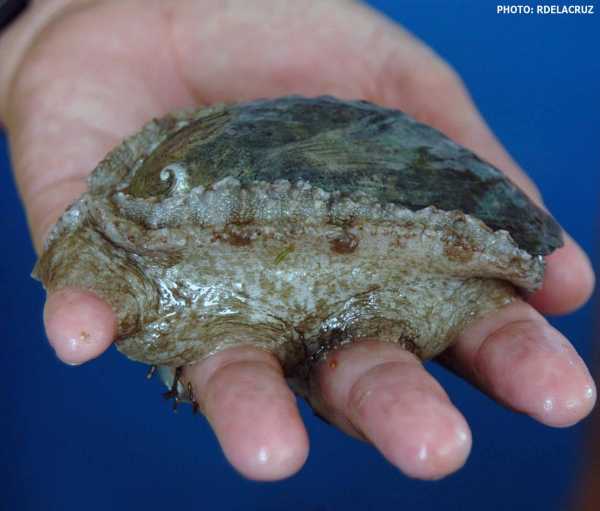Gone are the days when blue whales, great white sharks and bottlenose dolphins dominate the seas. For the longest time, these majestic sea creatures were the focus of human interest. But the tides of change have washed other equally interesting species ashore – one of them, is the abalone. Albeit strange-looking creatures, these sea snails are a lot more than meets the eye. They may look creepy and peculiar in the beginning, but that doesn’t mean that’s all there is to see.

Abalone belongs to the Phylum Mollusca in the family Haliotidae, along with octopus and squid, clams, sea slugs, and scallops and other edible sea snails. The abalone shell has a low and open spiral structure where several open respiratory pores line the outer edge. Abalone feed on marine aglae, specifically the algae known as glacilaria, which can be easily cultured. Its local name “kapinan,” “lapas,” or “sabra-sabra” is gaining popularity in the country as more and more research projects and initiatives are currently underway in culturing the once unknown abalone.
Abalone in the Philippine market
Across international waters, abalone is a known delicacy. Its price ranges from US$12–120 per kilo in China and Japan alone. It is known as one of the “biggest earners among exportable aquaculture in many countries” and its demand continues to rise, as does its cost. With a high international marketable value, this commodity proves to be a gold mine, especially for fishfarmers where the donkey’s ear abalone is abundant.
According to Southeast Asian Fisheries Development Center (SEAFDEC), abalone aquaculture may be in its infancy in the country, but with these initiatives available, commercial farms could be soon operational. Apart from the favorable weather that makes for various sites in the Philippines suitable to culture abalone, there are numerous methods that can be applied to increase its production. The species can be cultured in pens, ponds, and tanks. In the country for example, some grow-out farms use buckets, plastic barrels, or perforated drums that are anchored to the ocean floor, or net cages suspended from buoys. This is recommended as water will be free flowing from any direction, and ensures high surface-to-volume ratio.
In 2006, the Philippines used to be the top frozen abalone exporter to Hong Kong. It also supplied abalone to other Asian countries such as Japan, Korea, Taiwan, Australia and Singapore. Locally, abalone costs around Php 750–800 per can, but demands a higher price across international waters when exported—making it a one-billion dollar world market value. These numbers alone are enough to encourage more research and development (R&D) initiatives, and more practitioners of abalone aquaculture in the Philippines.
Bohol takes on abalone
In the Central Visayas region, the island province of Bohol takes a big leap in abalone aquaculture. The joint effort of the Department of Agriculture – Bureau of Agricultural Research (DA-BAR) and the DA-Bureau of Fisheries and Aquatic Resources (BFAR) Region VII, lead by the Central Visayas Regional Fisheries Research and Development Center (CVRFRDC), a project titled, “Growth and Survival of Abalone (Haliotis asinina) Fed Different Seaweeds in Different Culture Units” was launched under BAR’s Community-based Participatory Action Research (CPAR). The main objective of the study is to determine better culture techniques to increase production and encourage more fishfarmers to take on abalone production as an alternative means of livelihood.
The make shift cages made from PVC pipes covered in plastic screens and perforated containers were set in the coastal waters of Barangay Lawis, Pangangan Island in Calape, Bohol. Every three days, abalone stocks in six separate cages were fed with experimental feed composed of fresh seaweeds, Gracilaria Sp. and Eucheuma. Growth weight of experimental abalone was determined after 458 days or 15 months. Results showed that higher growth was achieved in abalone set in PVC make-shift cages fed with Gracilaria feed.
With these results, local fishfarmers are presented with a method that will enable them to produce a high value commodity, with little investment capital. Though in the beginning, their production may not be for export, the increasing local demand will be supplied by our own Filipino fishermen. Further R&D initiatives such as those by BAR and other DA-attached agencies will help produce more information in culturing abalone, and soon we will be able to reap the benefits of becoming the world’s top supplier of the exquisite and very expensive abalone.
———–
*This article is based on the reports submitted for the project “Growth and Survival of Abalone (Haliotis asinine) Fed Different Seaweeds in Different Culture Units,” by proponents Galicana A. Toston (Sr. Aquaculturist) and Nimfa I. Mesina (Agriculturist II) of BFAR Region VII, CVRFRDC.
Source: Zuellen B. Reynoso, Bar Chronicle July 2012 Issue (Vol. 13 No. 7)